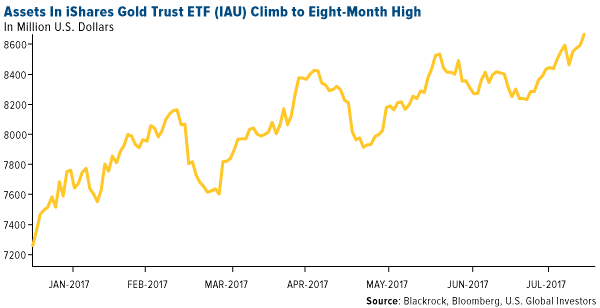What’s Next For The Yellow Metal?
Strengths
-
The best performing precious metal for the week was platinum, up 3.10 percent on money managers cutting their bearish views on the metal in light of the new Russian sanctions signed into law earlier in the week. Russia is the world’s second largest producer of platinum. Gold traders and analysts surveyed by Bloomberg are bullish on gold for a seventh week, reports Bloomberg, making it the longest run since early March. In addition, BullionVault’s Gold Investor Index, which measures client buyers against sellers, rose in July when gold prices reached an almost four-month low. The Perth Mint released gold coin and minted bar sales figures for July, coming in at 23,675 ounces and up from June’s figure of 19,259 ounces, reports Bloomberg.
-
In an attempt to push for more transparency, London Bullion Market Association released data showing its $298 billion gold stash, reports Bloomberg. The data will “soon be augmented by trade reporting, which will further enhance the ability of market participants as well as regulators to track and asses market activity,” said Joni Teves, a strategist with UBS in London.
-
In July, $2.4 billion was pulled from SPDR Gold Shares, the biggest withdrawal since May 2013, reports Bloomberg. However, investors weren’t necessarily abandoning bullion-backed ETFs; they may have been moving their money into less expensive options. As the chart below shows, assets in the iShares Gold Trust reached an eight-month high. Perhaps this is because SPDR Gold charges a fee of 40 basis points, while iShares Gold Trust has an expense ratio of 25 basis points.

Weaknesses
-
The worst performing precious metal for the week was silver, off 2.95 percent on the pull-back in gold prices. As reduced investment in gold ETFs outweighed higher jewelry and bar purchases, global gold demand dropped to a two-year low in the second quarter, reports Bloomberg. “It was always going to be hard to match last year’s demand, simply because ETF buying was so strong,” said Alistair Hewitt of the World Gold Council. The slowdown in ETFs contrasts with improved demand for other gold products, which has helped push prices up by 11 percent.
-
This is the second year in a row that policy changes in India may have strained gold sales, reports Bloomberg. Consumption is seen between 650 and 750 metric tons this year, compared to the annual average of around 850 tons in the previous half decade. The Indian government’s push to boost financial transparency cut consumption this year as they enacted a new consumer tax system, the article continues.
-
Declines in U.S. car sales, combined with still-elevated inventory levels, provide signals that “profit and leverage metrics may weaken throughout the auto food chain,” writes Bloomberg. This could prove worrisome for platinum and palladium, used in the manufacturing of vehicle emission systems.
Opportunities
-
Australian gold miners including Evolution Mining and Northern Star Resources may be required to look overseas for acquisitions to add operations of sufficient scale and quality, reports Global Mining Research Ltd. North America is likely to be their targeted destination. Last year Goldcorp Inc. pointed out that waning global gold output is likely to spur more deals and industry consolidation. “Mine supply may fall about a third in the 10 years to 2025,” according to Bloomberg calculations (based on forecasts from BMO Capital Markets and Randgold Resources).
-
Commodities have plenty of catch-up room to the dollar, reports Bloomberg. On a spot basis, ending July unchanged, the Bloomberg Commodity Index is set to gain, while the Bloomberg Dollar Spot Index declines 9 percent. Now that reflation fears have been mostly alleviated, Bloomberg continues, renewed commodity vigor appears to be in early days.
-
TriStar Gold announced assay results from reverse circulation drill holes at the Castelo de Sonhos gold project in Brazil, showing significant new gold reefs. According to the company, several individual intervals in the new holes exceed 10 grams per ton, cutting 1m at 27.8 grams per ton. Some of the individual reefs in the new holes are considerably thicker than the deposit average, the report continues. Another company announcement comes from Pure Gold Mining Inc., noting a new mineral resource estimate at its 100 percent owned Madsen Gold Project. The company reports 1,648,000 indicated ounces of gold at Madsen and 178,000 inferred ounces of gold. This represents a 48 percent increase to indicated resource ounces.
Threats
-
Brown Brothers Harriman discusses the U.S. Treasury’s third quarter refunding plans in a note to investors this week. The group notes that on Monday, the Treasury said it projected borrowing at $96 billion in the third quarter ($2 billion less than June’s projection). “However, it signaled a surge in its borrowing needs for the fourth quarter; a whopping $501 billion,” writes BBH. This is perhaps the largest amount the federal government has tried to borrow since the fourth quarter crisis in 2008. “This is a huge amount of supply and appears to reflect the pay back for the extraordinary measures to circumvent the debt ceiling,” coming up for negotiation in the third quarter the article continues.
-
Bloomberg notes three signals showing hedge funds are losing precious metals faith: 1) In the week ended July 11, the net-long position in gold fell to the lowest in 17 months, prior to the metal posting its first weekly gain in six weeks. 2) Silver is also losing its luster as the position by hedge funds in the white metal swung to a net-short from a net-long, making it the most bearish since August 2015. 3) Money managers pushed their net-short position in platinum to a record before data showed European car sales slowed in June.

As Sibanye Gold joins AngloGold Ashanti in looking to close unprofitable shafts in order to stem losses, more than one in 10 gold mining jobs in South Africa could disappear, reports Bloomberg. South Africa produced more gold than any other country for a century until 2007 the article continues, but depleted reserves and rising costs have meant production and jobs have tumbled since the industry’s heydays of the 1970s and 1980s.






 Frank Holmes is the CEO and Chief Investment Officer of
Frank Holmes is the CEO and Chief Investment Officer of 









